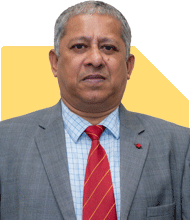Will a 20K SIP Investment Yield Good Returns by Age 60?
Ramalingam Kalirajan |8093 Answers |Ask -Follow
Mutual Funds, Financial Planning Expert - Answered on Oct 07, 2024
He has an MBA in finance from the University of Madras and is a certified financial planner.
He is the director and chief financial planner at Holistic Investment, a Chennai-based firm that offers financial planning and wealth management advice.... more

I am age of 50. .. 20K to invest in SIP , would be OK, to get good returns at age of 60 Y?
Let’s assess how to make the most of this Rs 20,000 monthly SIP.
Time Horizon and Investment Strategy
1. 10-Year Time Frame
Since you have 10 years, your focus should be on investments that balance growth and safety. A decade is a reasonable time frame to invest in equity mutual funds, which offer the potential for higher returns compared to debt funds.
2. Balanced Approach
Though equity mutual funds can offer higher returns, it’s wise to diversify with debt mutual funds as well. Equity mutual funds provide capital appreciation, while debt mutual funds can add stability. This combination will help you manage risk, especially as you approach retirement.
Maximising Returns with Equity Funds
1. Growth Potential
Equity mutual funds generally outperform other assets over the long term. By investing Rs 20,000 per month for 10 years, you can benefit from the power of compounding. Actively managed funds with a focus on mid-cap and large-cap segments can offer higher returns, particularly with the guidance of a Certified Financial Planner (CFP).
2. Volatility and Risk Management
While equity investments offer higher returns, they can also be volatile in the short term. Since your goal is 10 years away, the volatility will likely even out, providing you with significant returns. However, it’s essential to have a portion of your investments in less risky options like debt mutual funds as you near retirement.
Debt Mutual Funds for Stability
1. Safer Investments
Debt mutual funds offer more stable and predictable returns compared to equity funds. By allocating a portion of your Rs 20,000 SIP to debt funds, you ensure that part of your portfolio is protected from market volatility. This is particularly important as you approach your retirement years when preserving capital becomes crucial.
2. Tax Implications
Debt mutual funds are subject to capital gains tax, which is based on your income tax slab. Long-term capital gains (LTCG) and short-term capital gains (STCG) from debt mutual funds are taxed as per your income tax bracket. It’s important to be aware of this when you plan your withdrawals.
The Importance of Diversification
1. Balance Between Equity and Debt
Your Rs 20,000 SIP should not be entirely focused on one type of investment. A well-diversified portfolio with a mix of equity and debt funds can help you achieve your retirement goals while managing risk effectively. Diversification reduces the impact of volatility and helps in generating steady returns.
2. Periodic Portfolio Review
It is vital to review your portfolio regularly. As you get closer to retirement, you may want to gradually shift more of your SIP from equity to debt funds. This will help protect your accumulated wealth and ensure that your capital is safe from market fluctuations as you near the time when you’ll need it.
Benefits of Actively Managed Funds
1. Expert Fund Management
Actively managed mutual funds are managed by experienced fund managers who adjust the portfolio based on market conditions. This approach helps to capture opportunities and manage risks, offering better returns over time.
2. Avoid Direct and Index Funds
While direct and index funds may seem cost-effective, they lack the professional guidance provided by certified mutual fund distributors (MFDs) and CFPs. Index funds, for instance, simply mirror the market and may not outperform during volatile times. Actively managed funds offer flexibility and expertise, helping you get better results, especially when investing for 10 years.
SIP as a Disciplined Investment
1. Power of SIP
Systematic Investment Plans (SIP) ensure that you invest regularly, regardless of market conditions. This not only helps in building a habit of saving but also allows you to benefit from rupee-cost averaging. Investing Rs 20,000 every month will help you accumulate wealth gradually while mitigating the impact of market volatility.
2. Long-Term Focus
Since you are investing with a 10-year horizon, you should focus on wealth creation and not worry about short-term market movements. SIPs help you stay invested during both good and bad times, allowing your investments to grow over the long term.
Tax Efficiency and Planning
1. Equity Mutual Fund Taxation
The gains from equity mutual funds are taxed based on whether they are long-term or short-term. Long-term capital gains (LTCG) over Rs 1.25 lakh are taxed at 12.5%, while short-term capital gains (STCG) are taxed at 20%. Being mindful of these tax rules can help you plan withdrawals in a tax-efficient manner.
2. Debt Mutual Fund Taxation
As mentioned earlier, the gains from debt mutual funds are taxed according to your income tax slab. This is something to consider when deciding on how much of your SIP should go towards debt mutual funds.
Preparing for Retirement
1. Accumulating a Sufficient Corpus
With a Rs 20,000 monthly SIP, you are taking a significant step toward building a retirement corpus. However, it’s essential to evaluate whether this amount will be enough to meet your post-retirement needs. You may want to consider increasing your SIP contributions as your income grows over the next few years.
2. Regular Review and Adjustments
Your financial situation and market conditions will change over the next 10 years. Therefore, it’s crucial to regularly review your investment strategy and make adjustments as needed. Consulting with a Certified Financial Planner (CFP) can help ensure that your investments stay aligned with your long-term goals.
Building Wealth for the Future
1. Secure Future with SIP
Your commitment to a Rs 20,000 SIP is an excellent way to secure your financial future. With consistent investing and the right mix of equity and debt, you can create a significant corpus by the time you retire.
2. Stay Focused on Long-Term Goals
While short-term market fluctuations may cause concern, staying focused on your long-term goals is key. SIPs, when coupled with a diversified portfolio, will help you stay on track and achieve your financial objectives.
Finally
To summarise, a Rs 20,000 SIP over 10 years can generate significant returns and help you build a healthy retirement corpus. By maintaining a balanced approach between equity and debt, and seeking guidance from a Certified Financial Planner (CFP), you can ensure that your investments grow efficiently and provide the financial security you need at 60.
It’s essential to stay disciplined with your SIP contributions, review your portfolio regularly, and adjust based on your risk tolerance and market conditions. With the right strategy in place, you’ll be well-prepared for your retirement years.
Best Regards,
K. Ramalingam, MBA, CFP,
Chief Financial Planner,
www.holisticinvestment.in
https://www.youtube.com/@HolisticInvestment
You may like to see similar questions and answers below
Ramalingam Kalirajan |8093 Answers |Ask -Follow
Mutual Funds, Financial Planning Expert - Answered on May 08, 2024
Ramalingam Kalirajan |8093 Answers |Ask -Follow
Mutual Funds, Financial Planning Expert - Answered on May 09, 2024
Ramalingam Kalirajan |8093 Answers |Ask -Follow
Mutual Funds, Financial Planning Expert - Answered on May 14, 2024
Milind Vadjikar |1101 Answers |Ask -Follow
Insurance, Stocks, MF, PF Expert - Answered on Jan 10, 2025
Inderpaul Singh |47 Answers |Ask -Follow
Leadership Coach - Answered on Mar 12, 2025
T S Khurana |398 Answers |Ask -Follow
Tax Expert - Answered on Mar 12, 2025
T S Khurana |398 Answers |Ask -Follow
Tax Expert - Answered on Mar 12, 2025
Rajesh Kumar Singh |192 Answers |Ask -Follow
IIT-JEE, GATE Expert - Answered on Mar 12, 2025
T S Khurana |398 Answers |Ask -Follow
Tax Expert - Answered on Mar 12, 2025
Aamish Dhingra |14 Answers |Ask -Follow
Life Coach - Answered on Mar 12, 2025
Kanchan Rai |554 Answers |Ask -Follow
Relationships Expert, Mind Coach - Answered on Mar 12, 2025
Kanchan Rai |554 Answers |Ask -Follow
Relationships Expert, Mind Coach - Answered on Mar 12, 2025
Prof Suvasish Mukhopadhyay |499 Answers |Ask -Follow
Career Counsellor - Answered on Mar 12, 2025
Prof Suvasish Mukhopadhyay |499 Answers |Ask -Follow
Career Counsellor - Answered on Mar 12, 2025




























